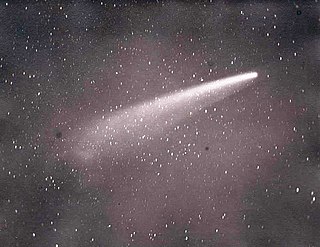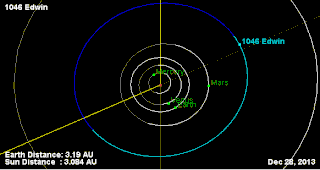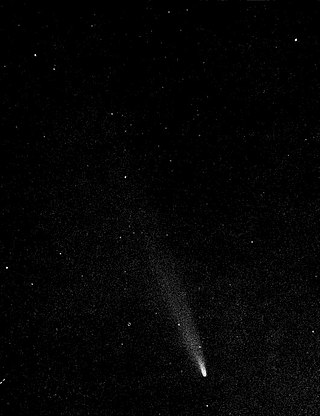Related Research Articles

Comet Hale–Bopp is a comet that was one of the most widely observed of the 20th century and one of the brightest seen for many decades.

Comet Ikeya–Seki, formally designated C/1965 S1, 1965 VIII, and 1965f, was a long-period comet discovered independently by Kaoru Ikeya and Tsutomu Seki. First observed as a faint telescopic object on September 18, 1965, the first calculations of its orbit suggested that on October 21, it would pass just 450,000 km (280,000 mi) above the Sun's surface, and would probably become extremely bright.

12P/Pons–Brooks is a periodic comet with an orbital period of 71 years. Comets with an orbital period of 20–200 years are referred to as Halley-type comets. It is one of the brightest known periodic comets, reaching an absolute visual magnitude of about 5 in its approach to perihelion. Comet Pons-Brooks was conclusively discovered at Marseilles Observatory in July 1812 by Jean-Louis Pons, and on its next appearance in 1883 by William Robert Brooks. There are ancient records of comets that are suspected of having been apparitions of 12P/Pons–Brooks.

George A. Van Biesbroeck was a Belgian–American astronomer. He worked at observatories in Belgium, Germany and the United States. He specialized in the observation of double stars, asteroids and comets. He is notable for his long career as an observational astronomer.

A sungrazing comet is a comet that passes extremely close to the Sun at perihelion – sometimes within a few thousand kilometres of the Sun's surface. Although small sungrazers can completely evaporate during such a close approach to the Sun, larger sungrazers can survive many perihelion passages. However, the strong evaporation and tidal forces they experience often lead to their fragmentation.

The Great Comet of 1882 formally designated C/1882 R1, 1882 II, and 1882b, was a comet which became very bright in September 1882. It was a member of the Kreutz Sungrazers, a family of comets which pass within 1 R☉ of the Sun's photosphere at perihelion. The comet was bright enough to be visible next to the Sun in the daytime sky at its perihelion. The comet made its closest approach to Earth on 16 September 1882 at 0.99 AU and then came to perihelion the next day on 17 September.
The Kreutz sungrazers are a family of sungrazing comets, characterized by orbits taking them extremely close to the Sun at perihelion. At the far extreme of their orbits, aphelion, Kreutz sungrazers can be a hundred times farther from the Sun than the Earth is, while their distance of closest approach can be less than twice the Sun's radius. They are believed to be fragments of one large comet that broke up several centuries ago and are named for German astronomer Heinrich Kreutz, who first demonstrated that they were related. These sungrazers make their way from the distant outer Solar System to the inner Solar System, to their perihelion point near the Sun, and then leave the inner Solar System in their return trip to their aphelion.

53P/Van Biesbroeck is a periodic comet 7 km in diameter. Its current orbital period is 12.53 years.

13P/Olbers is a periodic comet with an orbital period of 69 years. It fits the classical definition of a Halley-type comet with. The comet had last been seen in 1956 and the next perihelion is on 30 June 2024.

1046 Edwin, provisional designation 1924 UA, is a background asteroid from the outer regions of the asteroid belt, approximately 30 kilometers kilometers in diameter. It was discovered on 1 December 1924, by Belgian–American astronomer George Van Biesbroeck at the Yerkes Observatory in Wisconsin, United States, who named it after his son, Edwin Van Biesbroeck. The potentially metallic asteroid has a short rotation period of 5.29 hours.

Comet McNaught, also known as the Great Comet of 2007 and given the designation C/2006 P1, is a non-periodic comet discovered on 7 August 2006 by British-Australian astronomer Robert H. McNaught using the Uppsala Southern Schmidt Telescope. It was the brightest comet in over 40 years, and was easily visible to the naked eye for observers in the Southern Hemisphere in January and February 2007.

Comet 96P/Machholz or 96P/Machholz 1 is a short-period sungrazing comet discovered on May 12, 1986, by amateur astronomer Donald Machholz on Loma Prieta peak, in central California using 130 millimetres (5.1 in) binoculars. On June 6, 1986, 96P/Machholz passed 0.404 AU from the Earth. 96P/Machholz last came to perihelion on January 31, 2023. The comet has an estimated diameter of around 6.4 km (4.0 mi).

The Great Comet of 1901, sometimes known as Comet Viscara, formally designated C/1901 G1, was a comet which became bright in the spring of 1901. Visible exclusively from the southern hemisphere, it was discovered on the morning of April 12, 1901 as a naked-eye object of second magnitude with a short tail. On the day of perihelion passage, the comet's head was reported as deep yellowish in color, trailing a 10-degree tail. It was last seen by the naked eye on May 23.

C/2012 F6 (Lemmon) is a long-period comet discovered in Leo on 23 March 2012, by A. R. Gibbs using the 1.5-m reflector at the Mt. Lemmon Survey, located at the summit of Mount Lemmon in the Santa Catalina Mountains north of Tucson, Arizona, USA. Initially, the object was considered to be of asteroidal nature before later observations confirmed its cometary appearance. Comet Lemmon has a highly eccentric orbit, bringing it as close to 0.73 AU from the Sun at perihelion and as far as 973 AU from the Sun at aphelion. This also leads to the comet's long-period nature with an orbital period of approximately 8,000 years based on epoch 2050. The comet last reached perihelion on 24 March 2013.

61P/Shajn–Schaldach is a periodic comet in the Solar System with a current orbital period of 7.49 years.

Comet Mrkos, formally known as C/1957 P1, was a non-periodic comet discovered in 1957 by Antonín Mrkos. It was one of two bright comets that had their perihelion in 1957, the other being Comet Arend–Roland. Its peak magnitude was estimated to be around 1 and it has been characterised as a great comet.

C/2021 A1 (Leonard) was a long period comet that was discovered by G. J. Leonard at the Mount Lemmon Observatory on 3 January 2021 when the comet was 5 AU (750 million km) from the Sun. It had a retrograde orbit. The nucleus was about 1 km (0.6 mi) across. It came within 4 million km (2.5 million mi) of Venus, the closest-known cometary approach to Venus.

Comet Kohoutek is a comet that passed close to the Sun towards the end of 1973. Early predictions of the comet's peak brightness suggested that it had the potential to become one of the brightest comets of the 20th century, capturing the attention of the wider public and the press and earning the comet the moniker of "Comet of the Century". Although Kohoutek became rather bright, the comet was ultimately far dimmer than the optimistic projections: its apparent magnitude peaked at only –3 and it was visible for only a short period, quickly dimming below naked-eye visibility by the end of January 1974.

The Southern Comet of 1947 was a bright comet that became visible in the southern hemisphere in December 1947. At that point it was the brightest comet seen in two decades and is one of the brightest comets seen since 1935, with an estimated maximum apparent magnitude of -3.

C/2023 P1 (Nishimura) is a long-period comet discovered by Hideo Nishimura on 12 August 2023. The comet passed perihelion on 17 September 2023 and reached an apparent magnitude of about 2.5.
References
- ↑ "Small-Body Database Lookup: C/1931 P1 (Ryves)". ssd.jpl.nasa.gov. Retrieved 22 January 2024.
- 1 2 "Ryves Comet Passes at 100 Miles a Second; Heads for Void, Probably Never to Return". New York Times . August 28, 1931. p. 13.
- 1 2 3 4 Bower, E. C.; Miller, Mary L. (October 1931). "Comet 1931c (Ryves)". Publications of the Astronomical Society of the Pacific. 43 (255): 357. Bibcode:1931PASP...43..357B. doi:10.1086/124164.
- ↑ Ryves, P. M.; Shapley, H.; van Biesbroeck, G. (15 August 1931). "Comet Ryves (1931c)". International Astronomical Union Circular (331): 1. ISSN 0081-0304.
- ↑ "Elusive Ryves Comet Is Photographed; Yerkes Observer Gets Picture as Wanderer Rises on Horizon Ahead of Sun" . New York Times . October 9, 1931. p. 2.
- ↑ van Biesbroeck, G. (1931). "Comet Notes: Comet 1931 c (Ryves)". Popular Astronomy. 39: 546. Bibcode:1931PA.....39..546V. ISSN 0197-7482.
- ↑ Bower, Ernest Clare; Miller, Mary L. (1931). "Elements and ephemeris of Comet 1931c (Ryves)". Lick Observatory Bulletins. 15: 179–180. Bibcode:1931LicOB..15..179B. doi:10.5479/ADS/bib/1931LicOB.15.179B.

